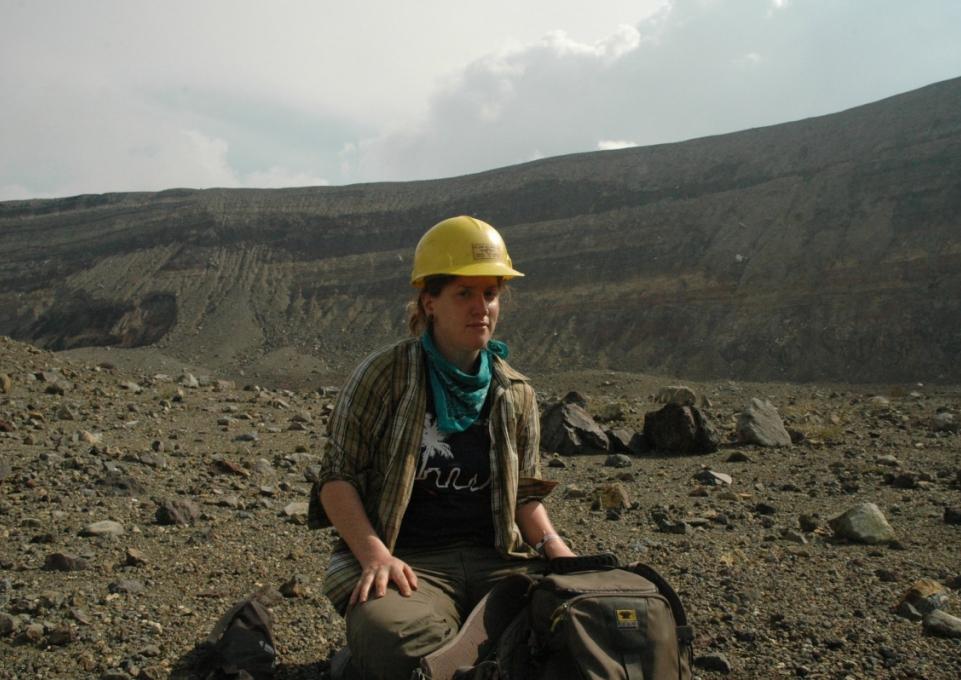
After receiving an electronic media, arts, and communication degree from Rensselaer Polytechnic Institute in Troy, Lis Gallant, ’12, moved to Buffalo and found a graphic design job.
Not liking the job, Gallant decided to go back to school at Buffalo State, hoping to become a science teacher. In her first lab class, Gallant’s professor, Bettina Martinez-Hackert, mentioned studying volcanoes, and asked if anyone was interested in assisting with research.
Gallant volunteered, and she has been enamored of volcanic eruptions ever since.
“Growing up, I didn’t even know this was an option,” she said of her newfound career.
Through her research at Buffalo State, Gallant traveled to El Salvador twice and to Australia, Washington, D.C., and San Francisco. She finished her degree in geology at Buffalo State in two years.
Now at the University of South Florida’s School of Geosciences, where she earned a master’s degree in geology in 2016, Gallant is aiming to get a Ph.D. in geology in August. Before heading to USF, Gallant held an internship at the Hawaiian Volcano Observatory, a position she said she would not have gotten had it not been for the work she did at Buffalo State.
“I wouldn’t have had that opportunity without the research background,” she said.
Jill Singer, a professor in the Earth Sciences and Science Education Department who taught Gallant in two courses, hired her to help run sediment samples using a Malvern particle sizer.
“Without a doubt in my mind,” Singer said, “Lis was clearly the brightest student in both classes and one of the brightest students I’ve had in my 30-plus years at Buffalo State. Her depth of understanding of the subject matter was repeatedly demonstrated by her ability to connect processes and concepts from one topic to another and appreciate the relationship between the subject [oceanography and sedimentology] and other geology courses.”
Gallant was awarded several grants through the Undergraduate Research Office, including travel grants to present her research at professional conferences and an undergraduate summer research fellowship.
“In addition to presenting at the American Geophysical Union meeting in San Francisco,” Singer said, “Lis presented her research at a meeting in Australia, and she was selected to present her research at the Council on Undergraduate Research’s Posters on the Hill in Washington, D.C.”
When most people think of volcanoes, they picture large ones like Mount St. Helens in Washington. Gallant’s work includes looking at smaller, more active distributed volcanic fields.
“It’s more difficult to predict where the next eruption is going to come from,” she said, noting that she uses computer models to guide her work. She is currently looking at the Snake River Plain in Idaho, which is especially important because there is a nuclear facility in the middle of the volcanic field.
“One of the big things in geology is that the past is key to the future,” she said. “Figuring out where the most vulnerable areas are is really important in terms of building infrastructure in the space.”
It’s a “cool” job, Gallant said, that can sometimes be dangerous. She’s been around for volcanic eruptions, like the ones from Nicaragua’s Momotombo in 2015 and Hawaii’s Kīlauea in 2013.
“I wouldn’t do it if it wasn’t interesting,” she said. “There are a lot of different kinds of people in volcanology, and some are really science driven. I am driven by solving problems that help society. But I really enjoy the scientific questions. I like to merge the two.”
As she transitions into a role where she’s working with undergraduate students in the field, Gallant said, she’s feels lucky to have worked with the faculty members at Buffalo State, like Martinez-Hackert and Singer, who helped lay the foundation for her success.
“To have that positive role model idea in my head from the start, I think it’s helped me be a better mentor to the people around me,” she said. “To have the support from my advisers both financially and personally—that was huge. That’s something that stuck with me. I learned what good mentoring is very early on in my career.
